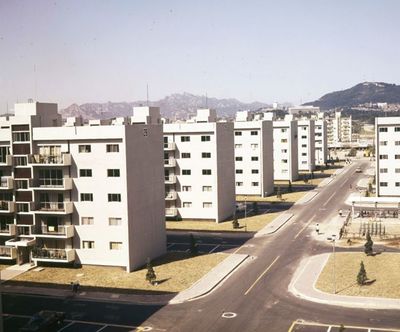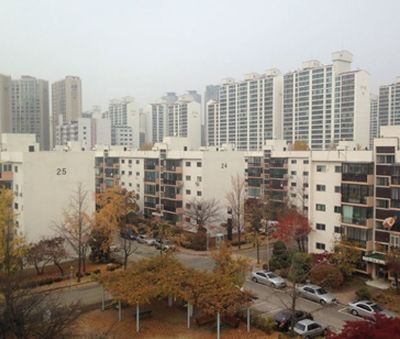The Korean House - SUPPLY OF APARTMENT COMPLEXES
SUPPLY OF APARTMENT COMPLEXES[1]
The collapse of the Wau Apartment buildings in April 1970 rapidly spread fear about apartment dwelling. The Wau disaster was caused by poor construction. The apartment had been constructed in a short period of time using cheap construction materials for the framework. As a result, construction on all public apartment projects ceased and plans to supply apartments to lower-class families were put on hold indefinitely.
For this reason, the government started targeting people who had newly joined the middle class due to economic development. In 1970, Hangang Mansion Apartment was built for 3,220 households in Dongbuichon-dong and the twelve-story Sibeom Apartment, the tallest apartment at the time, was built for 1,584 households in Yeouido. In particular, Hangang Mansion Apartment was the first luxury apartment to offer preconstruction sales by displaying a model house. Such an aggressive push by the government to convince prospective middle-class buyers to purchase apartments raised the price of the apartments. There were all sorts of expedients and trade-ups during the lottery drawing of Banpo Apartment in 1973 to convince people to buy them. The government was criticized for these efforts because they intentionally raised the price of the apartment to target the middle classes, even though their priority had been to supply apartments for the lower class. However, this public perception did not deter the government from the important project of developing Gangnam (the area south of the Hangang River).
The government implemented a number of institutional strategies to promote large-scale apartment complex development in the 1970s. The Housing Construction Promotion Act of 1972 and the Specific Area Development Promotion Act of 1973 were enacted, institutionalizing financial support for the private development of housing projects and offering tax reductions. Furthermore, the government also designated specific apartment districts, which prohibited all other forms of construction in these areas. Eleven districts and a total of 3,720,000 pyeong (about 12.2 square kilometers) were designated as apartment districts in 1976, including such neighborhoods as Banpo, Jamsil, and Apgujeong, a number that expanded to fourteen districts in 1979. Banpo Apartment Complex One had 1,490 households, Banpo Apartment Complexes Two and Three had 4,120 households, and Jamsil Apartment Complexes One through Five were constructed in 1973, 1977, and from 1975 to 1977, respectively. At the same time, large-scale apartment complexes, including the Apgujeong Hyundai Apartment built in 1975, were built by private construction companies. Consequently, Gangnam became a major apartment residential area of the middle class.
Starting in the 1970s, active construction of large-scale apartments by public and private construction companies based on the institutional framework of the government eventually led to the redevelopment of both cities and towns during the 1980s. This was the principal factor in producing Korean society’s modern uniform apartment culture. In the United States and Europe, apartment complexes were usually reserved for the lower classes. In contrast, the apartment complex in Korea was generally for the middle class, which resulted in closed, gated communities. Although there are large-scale apartment complexes available for the lower classes, an obvious classification and shunning of people living in rental apartments has generated social problems. There is an increasingly loud call for attention and reflection concerning numerous social and urban problems caused by large-scale apartment complexes, for which experts across sectors are seeking solutions.
Footnote
- ↑ Park Cheol-soo, Apateu (Apartment) (Seoul: Mati, 2013); Jeon BongHee and Kwon Yong-chan, Hanok-gwa Hanguk jutaek-ui yeoksa (History of hanok and the Korean House).

